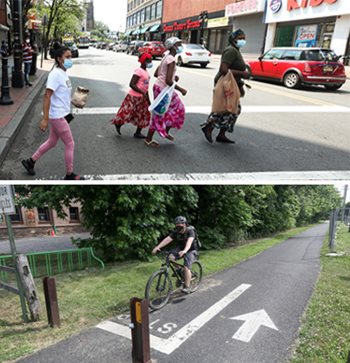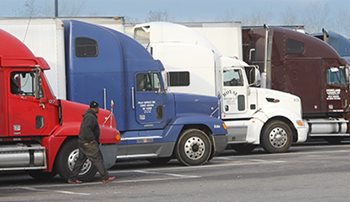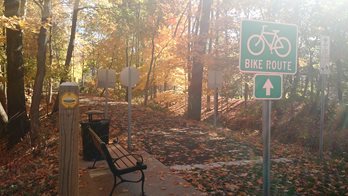September 2020
Posted: 9/18/2020 8:25:46 AM
 Improving “active transportation”—people’s ability to walk and bike—offers economic, health and environmental benefits to the region, according to a new paper published by the NJTPA.
Improving “active transportation”—people’s ability to walk and bike—offers economic, health and environmental benefits to the region, according to a new paper published by the NJTPA.
The NJTPA is publishing a series of background papers to inform its update of the region’s Long Range Transportation Plan, Plan 2050: Transportation, People, Opportunity, which is set to be adopted in fall 2021. The active transportation paper is the first to be published and can be viewed here.
The COVID-19 pandemic has added to the importance of walking and biking as a means of exercise, recreation and safe mobility, the paper notes. Increasingly, towns are adopting and implementing “complete streets” policies to better accommodate walking and biking and meet the needs of all travelers, young and old.
“The concept of ‘complete streets’ that meet the needs of everyone is no longer an academic planning vision but rather a main street reality,” said NJTPA Chair Kathryn DeFillippo, a Morris County Freeholder. “We've seen towns quickly transform and use sidewalks and streets in creative ways as never seen before.”
The paper notes that while automobiles remain essential for travel in the region—especially given the legacy of past auto-oriented planning and development practices—the NJTPA and its partner agencies seek to balance investments so that walking and biking are also encouraged and enabled.
It says expanding active transportation provides important benefits, including:
- supporting economically vital mobility, particularly for young people, elderly, low-income people and otherswithout vehicles;
- promoting healthy lifestyles to prevent chronic illnesses, particularly obesity;
- realizing a cleaner environment, including reducing 40 percent of greenhouse gas emissions and other pollutants generated by transportation; and
- enhancing quality of life and strengthened communities.
A key challenge identified is the need for improved infrastructure. While New Jersey has a network of more than 214 miles of off-road paths shared by bicyclists and pedestrians, expansion is needed to accommodate growing use and increasing population. For on-road facilities, network gaps—such as a missing section of sidewalk or a disjointed bicycle network—can pose a safety hazard and discourage people from cycling or walking.
Addressing safety must be a top priority, according to the paper. The state’s pedestrian fatality rate is nearly double the national average. Crashes are overrepresented on state and county facilities, among the busiest roads in the region, many of which lack adequate pedestrian and bike infrastructure.
Among the strategies identified for improving active transportation are:
- Extending sidewalks and adding safety features such as pedestrian countdown timers, high-visibility crosswalks and curb extensions.
- “Calming” streets, particularly in downtown or residential areas, by implementing road diets, decreased lane widths, speed humps and other measures.
- Improving the bicycle network with continuous routes consisting of multi-use trails, bicycle lanes, roads with ample shoulders or shared lanes.
- Improving access to transit through transit-oriented development, more bicycle parking, upgrading bus stops and improved lighting.
- Observing the federal Americans with Disabilities Act to accommodate those with mobility limitations and enhance access to destinations.
Several NJTPA programs support these and other strategies in cooperation with city and county subregions. In particular, NJTPA’s Local Safety and High Risk Rural Roads Programs provide funding on a competitive basis for multimodal safety treatments on local roads and at intersections. Also focusing on the local level, the Planning for Emerging Centers Program provides technical support to municipalities to create more sustainable, transit-supportive and walkable communities.
NJTPA study programs also directly address active transportation. Examples cited in the paper include: the Morris Canal Greenway Corridor Study, which identified strategies to realize a continuous greenway stretching 111 miles across the region; the JC Walks Jersey City Pedestrian Enhancement Plan, which included walkability workshops and demonstration projects; and the City of Passaic Main Avenue Corridor Improvements study investigating concepts for implementing a complete streets plan in the study area.
The NJTPA also works with numerous municipalities and the region’s eight Transportation Management Associations on the Street Smart NJ Pedestrian Safety Campaign to raise awareness of pedestrians, bicyclist and drivers about traffic regulations and safe travel behaviors. The NJTPA also actively coordinates with NJDOT and the New Jersey Division of Highway Traffic Safety on conducting safety audits around the region and developing and implementing New Jersey’s Strategic Highway Safety Plan.
To improve active transportation over the long term, the paper recommends the NJTPA: give priority to active transportation where possible in NJTPA plans and programs; explore creating an Active Transportation Plan for the region; promote education and public participation regarding active transportation; improve regional data; and expand available funding.
Posted: 9/17/2020 1:07:14 PM
 During the pandemic, truck drivers have been designated as essential workers and even hailed as heroes for keeping store shelves stocked and making life under quarantine possible. Can this goodwill be sustained to persuade communities to accommodate the critical need for expanded truck parking? That was among the questions discussed by public and private freight experts during a September 10 truck parking workshop.
During the pandemic, truck drivers have been designated as essential workers and even hailed as heroes for keeping store shelves stocked and making life under quarantine possible. Can this goodwill be sustained to persuade communities to accommodate the critical need for expanded truck parking? That was among the questions discussed by public and private freight experts during a September 10 truck parking workshop.
The virtual event, with more than 100 participants, was held to examine the critical shortage of truck parking in the New Jersey-Pennsylvania-New York-Connecticut area, which hampers goods movement and leads to unsafe practices such as trucks parking on ramps or shoulders. Finding solutions, the experts agreed, is much harder in urbanized areas in the Northeast due to high land costs, community opposition and competing land uses.
The event was organized by the Metropolitan Area Planning (MAP) Forum, a consortium of 10 Metropolitan Planning Organizations and Councils of Government from the four-state area. The Federal Highway Administration (FHWA) also was a sponsor.
The event featured three panels, one with private sector trucking experts, one with public sector representatives and one focusing on emergency truck parking, as well as briefings by the New York Metropolitan Transportation Council (NYMTC), FHWA, NJTPA, American Transportation Research Institute and TRANSCOM on current and recent work related to truck parking. A recording of the event is here.
The private sector panel included Darrin Roth, American Trucking Association; Thomas Weakley, Owner-Operator Independent Drivers Association; Lisa Mullings, National Association of Truck Stop Operators; Ellen Voie, Women In Trucking; and Stefano Pascucci, JFKIA truck stop operator. The NJTPA’s Anne Strauss-Wieder moderated the discussion. Among the points raised:
- While congestion has lessened due to the pandemic, lack of parking remains a critical concern of truck drivers serving the region. The shortage was particularly acute during the pandemic’s early weeks when some parking facilities closed.
- Unofficial, unsafe parking such as using road shoulders is concentrated along I-78 and close to New York City.
- Often state governments are slow to invest in truck parking because they view it as a capital expense rather than as a critical safety issue.
- Most rest areas in the Northeast are commercially run which limits the availability of spots compared to larger public facilities (such as at highway rest areas).
- Women truck drivers are greatly concerned about safety and often must choose parking locations that offer less chance of harassment.
- Clean restrooms, availability of running water and other amenities are essential at parking facilities, particularly with heightened cleaning requirements associated with the pandemic.
- Technology may allow for the equivalent of airport control towers to coordinate the parking, movement and pick-up/deliveries of trucks in urban areas.
- It is estimated that truck traffic will increase 30 percent nationwide over the next decade, adding to the demand for parking (and drivers).
- Enhancing public understanding and appreciation of trucking will be needed to find locations to expand parking and attract new drivers.
- Ideas for expanding truck parking include using off-hours space at malls, theaters and other facilities; redeveloping land near law enforcement facilities to enhance safety; expanding weigh stations and existing facilities; and reusing contaminated brownfields.
The public sector panel included David Rosenberg, New York State Department of Transportation; Diniece Mendes, New York City Department of Transportation; Genevieve Clifton, New Jersey Department of Transportation; Brian Hare, Pennsylvania Department of Transportation; and Mauricio Garcia-Theran, Connecticut Department of Transportation. Gerry Bogacz, NYMTC, served as moderator. Following the panel, Dan Walston, FHWA, summarized what was heard. Among the points raised:
- At the federal level, FHWA has actively helped regions plan for meeting truck parking needs by holding workshops across the country with participation by local officials, industry representatives, truckers and stakeholders.
- States such as New Jersey are increasingly recognizing the critical safety issues presented by truck parking shortages and working towards effective responses.
- A multifaceted approach is needed to create expanded parking because it requires addressing local zoning, land use, economic development and other issues.
- The public sector can do the initial analysis and investigation of sites and then work with the private sector, which can often act quicker, to implement plans.
- Truck parking accommodations can be considered as part of economic development for distribution centers and other land uses, including encouraging shared parking facilities or truck “bullpens.”
- Truck parking might be rebranded as “freight support facilities” to emphasize the public benefit of trucks. People could be educated about the role of trucks in fulfilling their e-commerce orders and demands for fast deliveries of goods.
The panel on emergency truck parking included Adam Lomasney, New York City Economic Development Corporation; Bethann Rooney, Port Authority of New York and New Jersey; Michael Pack, Pennsylvania Turnpike; and Bob Dolan, Lehigh Valley Freight Advisory Committee. Becky Bradley, Lehigh Valley Planning Commission, moderated the panel. Following the discussion, Gautam Mani, FHWA, summarized what was heard. Points raised included:
- In weather or other events that disrupt truck movement, drivers can face the logistical nightmare of not only dealing with the event but finding parking.
- State parks might be considered for emergency use for truck parking, but the access and amenities available at these locations must also be considered.
- Operations centers, such as the Pennsylvania Turnpike’s, draw on real time data and serve as hubs for managing emergency events, coordinating responses and informing truckers and other travelers.
- Communications apps, including third party apps provided by companies such as Waze and Drivewyze, are being used to communicate emergency information directly with truckers. Roadside variable message signs, such as announcing the availability of parking, are also important.
- Cell phone alerts are considered a highly effective means of rapidly communicating situations and actions to drivers.
- TRANSCOM can serve as a model for coordinating multistate efforts to create plans, training and simulations for responding to emergency events, including accommodating truck parking and staging.
- The hazard mitigation plans developed in many areas must be enhanced to address truck parking and movements during emergencies.
In closing remarks for the workshop, NJTPA Executive Director Mary D. Ameen emphasized that truck parking is an issue that can’t be addressed in isolation; it must be recognized “as a key component of a larger supply chain that affects national security, our general quality of life and the continuation of day-to-day operations.” She said the MAP forum would continue multi-state coordination to see that solutions are found and implemented. The MAP forum webpage on truck parking is here.
Posted: 9/2/2020 9:37:39 AM
 The New Jersey Department of Transportation, in partnership with NJTPA, is accepting applications for Transportation Alternatives Set-Aside Program funding.
The New Jersey Department of Transportation, in partnership with NJTPA, is accepting applications for Transportation Alternatives Set-Aside Program funding.
This program provides federal funds for non-traditional transportation related projects designed to strengthen the cultural, aesthetic and environmental aspects of the nation’s surface transportation network.
NJDOT is hosting webinars on September 17 and September 30 to provide information on the application process.
Municipal and county governments, regional transportation authorities, transit agencies, natural resource or public land agencies, tribal governments and other local or regional governmental entities responsible for transportation oversight are invited to submit applications by November 24, 2020.
Projects must fall into one of the following seven categories to be considered for funding:
- Design and construction of on-road and off-road trail facilities for pedestrians, bicyclists, and other nonmotorized forms of transportation
- Conversion and use of abandoned railroad corridors for trails for pedestrians, bicyclists, and other nonmotorized transportation users
- Construction of scenic turnouts, overlooks, and viewing areas
- Historic preservation and rehabilitation of historic transportation facilities both land and water such as buildings, structures and canals
- Community improvement activities, specifically: Streetscaping and corridor landscaping
- Environmental mitigation to address stormwater management, control, and water pollution prevention or abatement related to highway construction or due to highway runoff
- Reduce vehicle-caused wildlife mortality or to restore and maintain connectivity among terrestrial or aquatic habitats
In addition to the traditional grant criteria, consideration will be given to applications that provide additional benefits to vulnerable members of the community, including low-income residents, minorities, limited English proficiency, persons with disabilities, children and older adults.
For additional information
visit the Transportation Alternatives Set-Aside Program page.